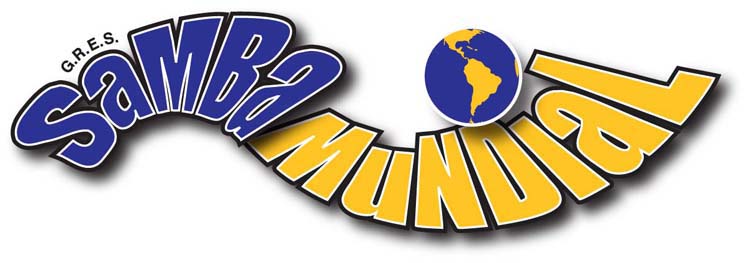
Samba Mundial was incorporated as a 501(c)3 non-profit corporation on
March 27, 2008.
However, the organization’s roots in the San Francisco Bay Area’s Brazilian
Samba community extend back to 1987!
History of our San
Francisco Carnaval Contingents
(Click here to see our Artwork, Enredos, and Floats)
Summary
Noe Valley Community Samba became Sambão Para O Povo which merged
with Brazil Culture and Arts.
Samba Mundial was founded and existed separately. Later, Sambão
Para O Povo split with
Brazil Culture and Arts (which later became Brazivedas). Finally,
the existing organization abandoned
the non-profit corporate structure and the name Sambão Para
O Povo, renamed itself Samba Mundial,
and founded a new non-profit corporate entity.
History
Noe Valley Community Samba was founded
by Jorge Duarte in 1987 and was associated with
a health food store in the Noe Valley area of San Francisco where Jorge
worked. An early history of the
organization written by Joanne Brion (past Sambão Treasurer
and President) contains the names of the
original leadership and earlier associations with other groups.
(Early History)
Noe Valley Community Samba (Link) became incorporated as Sambão
Para O Povo on October 26, 1990
and applied for its tax exempt status as a non-profit corporation at
that time.
Transitions
The history of the organization between 1991 and 1996 is not well known
to the writer.
Based on stories told by associates in the Bay Area samba scene, Jorge
Duarte handed off the
organization and the non-profit corporation to Maria Souza, founder
of Aquarela, one of the older
and most respected Samba dance troupes in the San Francisco Bay Area.
[Editor’s note: We think that Maria was Queen of SF Carnaval
in 1994 and founded Aquarela at or near that time.]
Eventually, Maria handed off the non-profit corporation to Mestre Beiçola,
founder of Brazil Culture and Arts (and later Brazivedas).
Meanwhile, in 1995, a group called Samba Mundial was created and participated
in San Francisco Carnaval in 1995 and 1996.
The original Samba Mundial was founded by Jeff Taylor (AKA: JETA) and
included Anita Lusebrink, Jeff Hanson,
Jimmy Biala (later founder of Sambasia San Francisco, Taipei, and Beijing),
and Brad Hamilton (writer and founding CEO of the current Samba Mundial).
After two years with a modest contingent, Jeff Taylor returned to teaching
Afro-Cuban music instead of leading a Samba group.
Anita Lusebrink left Samba Mundial after 1995 and joined Beiçola’s
Brazil Culture and Arts. After 1996, Brad Hamilton along
with the remaining bateria members also joined Brazil Culture and Arts,
which by that time was also known as Sambão Para O Povo.
The BCA Years (Brazil Culture and Arts)
From 1997 until 2001 the group participated in the San Francisco Carnaval
parade as Sambão Para O Povo/Brazil Culture and Arts
as a single group with two names. For the parade, the group partnered
with Aquarela in 1996, 1997, and 1998.
Additionally, in 1996 and 1997 the parade contingent also included
Mochidade Independencia de Los Angeles (M.I.L.A) in
a three group partnership. Note that the relationship between
Maria Souza of Aquarela and Mestre Beiçola of BCA was quite strong
in 1996 and may have something to do with Beiçola becoming the
leader of Sambão Para O Povo the non-profit entity.
We would need to check with these two individuals in order to hash
out this part of the history!
A Separate Sambão Para O Povo
In 2001 the non-profit corporation Sambão Para O Povo and Beiçola’s
sole proprietorship Brazil Culture and Arts had been
operating as a single entity for four years. Recognizing that
the non-profit corporation needed to function financially separately from
BCA,
an election was held to establish separate leadership for Sambão
Para O Povo. At the time, the plan was to continue operating
as a unified group, but keep separate books in order to maintain the
integrity of the non-profit status of the 501(c)3 entity.
However, in 2001, Beiçola had also invited Cristina Ribeiro to
join the group as a choreographer. Cristina ended up composing
the group’s enredo in 2001 and 2002. By the fall of 2001 when
the election was completed, it was decided that Sambão Para O Povo
would operate separately from Brazil Culture and Arts with Cristina
leading the dancer component and Brad Hamilton leading the bateria.
The officers of Sambão Para O Povo elected at that time were
Glenn Evans (President), Dierdre (Secretary) and Ken Lindsey (Treasurer).
In the spring of 2002 Dierdre and Ken were replaced by Craig Lawson
(Secretary) and Ted Syrett (Treasurer). In January 2003,
Cristina Ribeiro left the organization along with Craig Lawson who
was replaced by Lisa Ruiz as Secretary. In 2004, Sandy Del Rio
formerly took over as dance director. With Sandy as dance director,
and Brad as bateria director the organization ran under this leadership
structure until the summer of 2007.
A new but old name and a new organization
By the summer of 2007 the corporate entity Sambão Para O Povo
was in poor standing. Its corporate status had been “suspended”
by the state of California. It was decided that the current organization
would re-name itself and establish a new non-profit corporation
to support its activities. The old corporate entity Sambão
Para O Povo still exists with Glenn Evans but has been separate and
independent from what is now Samba Mundial since the summer of 2007.
Samba Mundial formed a proper Board of Directors and registered as a
non-profit corporation on March 27, 2008 (California Corporate ID #C3098593).
The organization received its Letter of Determination from the Internal
Revenue Service granting tax exempt status on February 18, 2009,
effective back to the date of incorporation (3/27/2008).
Samba Mundial is also registered with the State of California Attorney
General’s
Registry of Charitable Trusts (CT0149819).
History of SF Carnaval Parade Contingents (Pending)
Additional SF Samba Scene History (Pending)